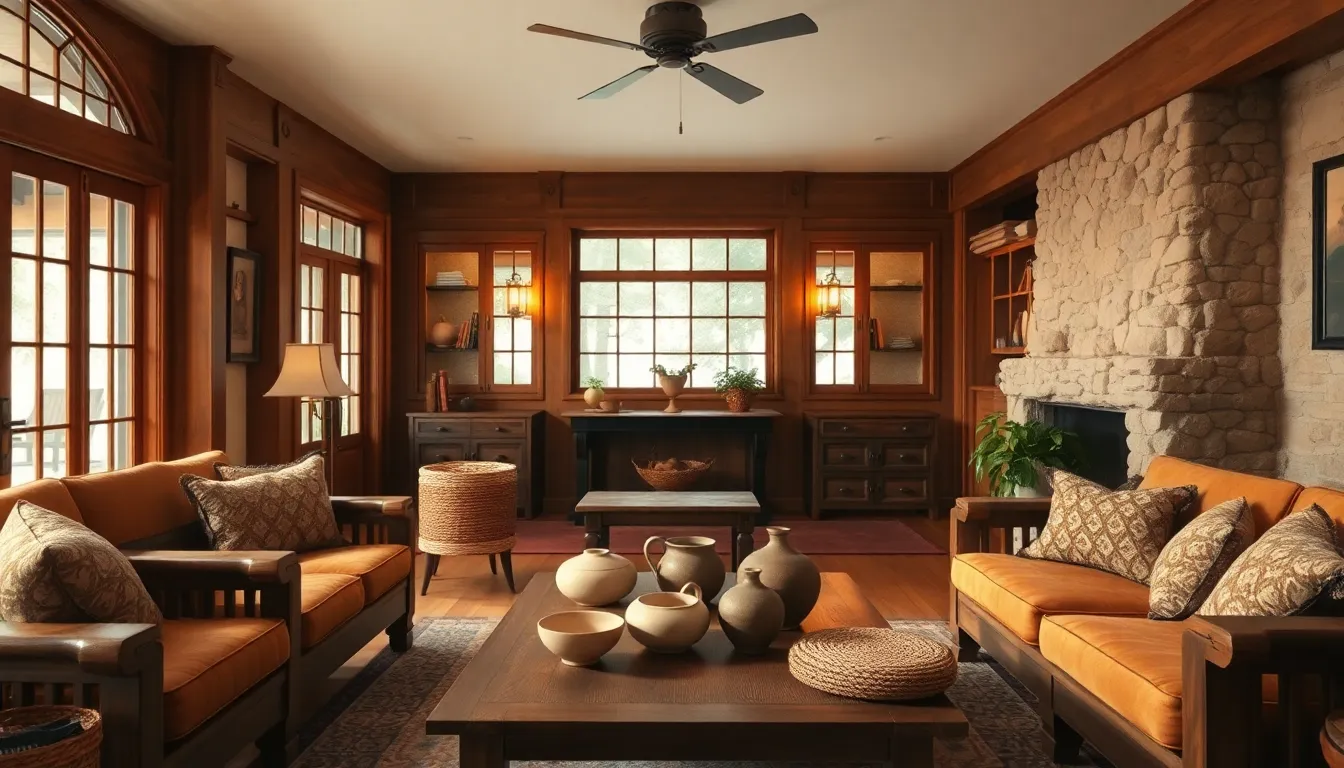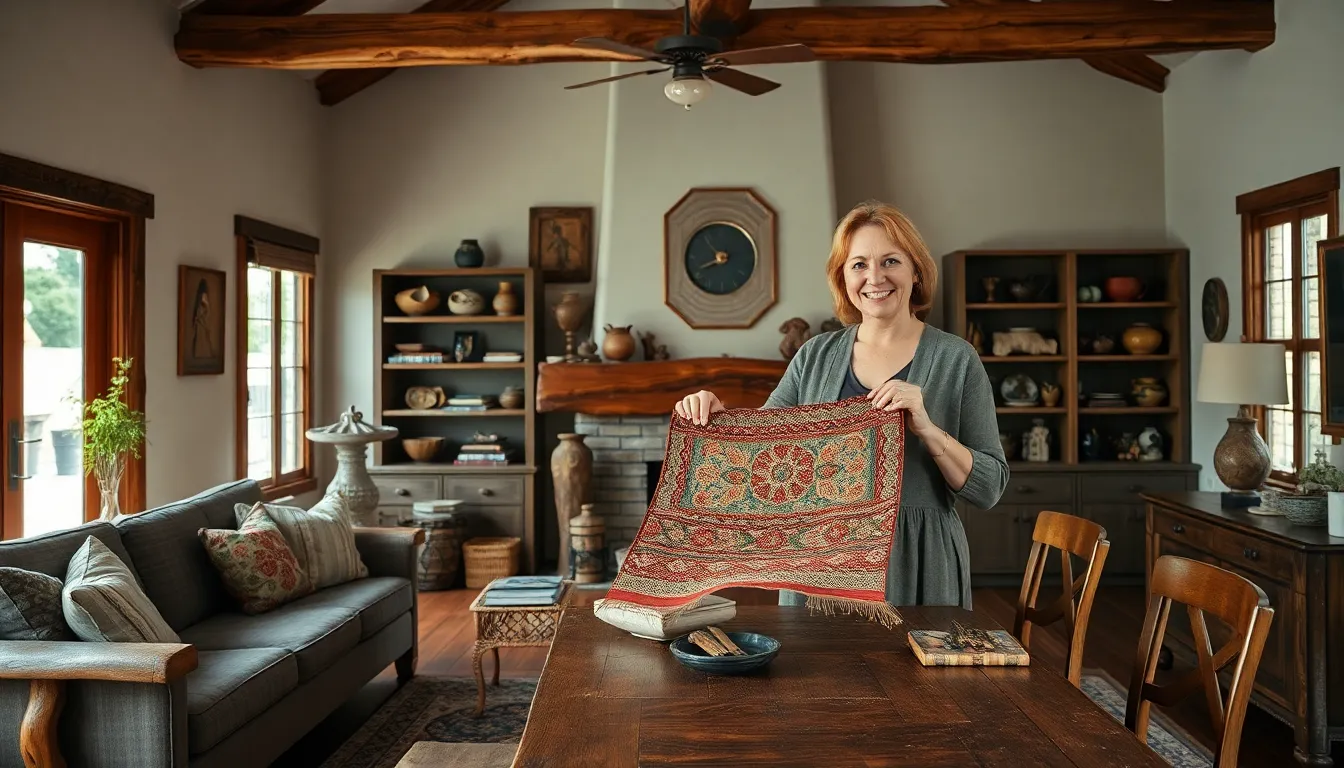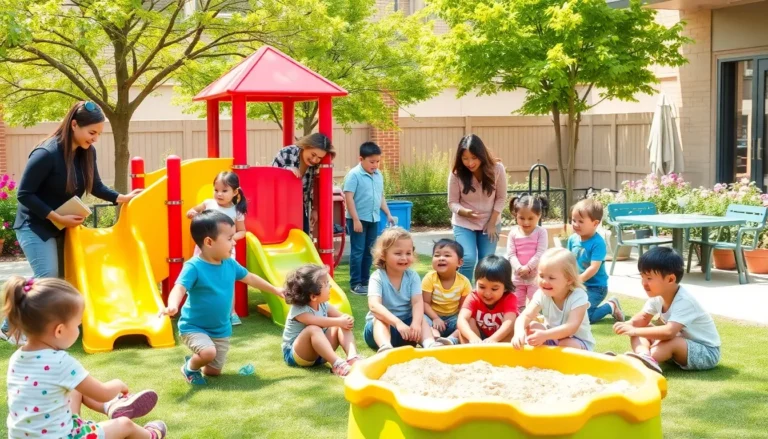In a world where cookie-cutter homes dominate, arts and crafts interior design emerges as a refreshing breath of creativity. This style celebrates handcrafted beauty and invites warmth into any space. Imagine walking into a room that feels like a cozy hug from your favorite grandparent—complete with unique furniture and charming decor that tells a story.
Table of Contents
ToggleOverview of Arts and Crafts Interior Design
Arts and crafts interior design celebrates the values of craftsmanship and simplicity in home decor. This style features natural materials like wood, stone, and metal, creating a warm and inviting atmosphere. It prioritizes functionality without sacrificing aesthetic appeal, resulting in spaces that feel both practical and beautiful.
Key characteristics often include handcrafted furniture, textiles, and art pieces. Handcrafted furniture usually highlights the skill of artisans and embraces imperfections that tell a story. Textiles, such as woven rugs and handmade curtains, complement the room’s overall design, adding texture and richness.
Another significant aspect involves incorporating earth tones and muted colors. These warm hues evoke a sense of calm, encouraging a cozy environment. Decorative elements like ceramic pottery and stained glass contribute to a homey feel while reflecting the individuality of the inhabitants.
Sustainable practices play a role in arts and crafts design. Using reclaimed wood and eco-friendly finishes showcases a commitment to the environment. This approach appeals to those seeking to create spaces that align with their values.
Moreover, architectural details add to the charm. Beamed ceilings, built-in shelving, and large fireplaces often serve as focal points in such interiors. These features enhance character and guide the layout of furniture and decor strategically.
Enthusiasts appreciate this design style for its ability to connect the past with the present. The emphasis on handmade quality resonates deeply, promoting a lifestyle that values authenticity and personal expression. By embracing arts and crafts design, individuals create homes that tell their unique stories while offering warmth and comfort.
Key Characteristics of Arts and Crafts Style

Arts and crafts style emphasizes unique qualities that enhance home decor. Highlights include natural materials, handcrafted elements, and a focus on sustainable living.
Natural Materials and Textures
Natural materials define the essence of arts and crafts interior design. Wood, stone, and metal create a tactile experience, adding warmth and authenticity to spaces. Furniture often features rich grain patterns, highlighting the beauty of nature. Textures play a vital role in the overall aesthetic, with woven fabrics and hand-turned objects offering visual interest. These elements evoke a sense of comfort and connection to the environment, establishing a cozy atmosphere within homes.
Handcrafted Elements
Handcrafted elements showcase the dedication of skilled artisans. Furniture pieces often display meticulous joinery and thoughtful design. Decorative accessories, such as ceramics and textiles, reflect individuality and craftsmanship. Each piece tells a story, contributing to a home’s personalized ambiance. Imperfections in materials enhance charm, reminding residents of the human touch involved in creation. Such elements breathe character into the living space while reinforcing the commitment to quality and authenticity.
Color Palette and Patterns
Selecting the right colors and patterns plays a vital role in achieving the essence of arts and crafts interior design. This style hinges on creating a harmonious atmosphere that combines beauty with a sense of comfort.
Earthy Tones and Warm Hues
Earthy tones serve as the foundation for this design style, offering a connection to nature. Shades like deep greens, rich browns, and muted golds exude warmth, inviting relaxation and tranquility. These colors complement natural materials, enhancing the tactile experience found in wood and stone elements. Warm hues add depth to living spaces, highlighting handcrafted furniture and textiles. Accent colors can introduce pops of life while maintaining a cohesive look. Creating a balanced palette with these earthy tones ensures a cozy yet sophisticated environment.
Decorative Motifs
Decorative motifs contribute significantly to the overall aesthetic of arts and crafts interiors. Patterns inspired by nature, such as floral or geometric designs, add visual interest. Incorporating motifs in textiles, wallpaper, and art pieces reinforces the connection to craftsmanship. Each pattern tells a story, reflecting the artisans’ dedication to their work. Unique elements like hand-painted tiles and stained glass windows enhance the artistic flair. By using decorative motifs thoughtfully, spaces exude individuality while celebrating the simplicity and charm inherent in this design philosophy.
Furniture and Decor
Furniture and decor play a vital role in the arts and crafts interior design style. They create a unique atmosphere that showcases both functionality and beauty.
Functional and Aesthetic Pieces
Functional pieces embody the spirit of the arts and crafts movement. Tables, chairs, and cabinetry often feature simple lines and sturdy construction. Handcrafted items, such as rustic dining tables, serve as focal points. Every piece serves a purpose while contributing to the overall design aesthetic. Homeowners often choose items made from natural materials, reflecting their commitment to sustainability. These selections prioritize durability and timeless design.
Importance of Craftsmanship
Craftsmanship forms the backbone of arts and crafts interior design. Skilled artisans invest time and effort into every furniture piece, resulting in high-quality creations. Woodworkers, metalworkers, and textile artists showcase their talents through intricate joinery and unique designs. Each item tells a story of dedication and creativity. Opting for handcrafted decor encourages sustainability and adds character to spaces. Individuals appreciate the distinctive touches that elevate personalized interiors. This emphasis on quality and artistry enhances the overall aesthetic appeal.
Incorporating Arts and Crafts in Modern Homes
Incorporating arts and crafts style in modern homes enhances warmth and personality. Unique handcrafted furniture adds character to living spaces, showcasing artisans’ skills while promoting sustainability. Rich textures from natural materials like wood and stone create tactile experiences, inviting touch and engagement.
Earthy color palettes provide a calming backdrop, allowing deeper shades of greens and browns to complement the overall aesthetic. Spacing and layout play crucial roles in achieving harmony, especially with architectural details such as beamed ceilings that draw the eye upward. Decorative elements like ceramic pottery and stained glass windows introduce artistic flair, reinforcing individual expression within the home.
Functional items stand out, offering both utility and beauty. Rustic dining tables serve as gathering places, while sturdy cabinetry reflects quality craftsmanship. Each handmade piece contributes to a narrative, celebrating unique stories that connect occupants to their surroundings.
Textures enhance visual interest, ensuring spaces feel inviting. Natural fibers in textiles, along with floral and geometric motifs, promote a sense of nature inside the home. Quality and artistry define this design movement, making each interior distinctive and a true reflection of its inhabitants.
Combining historical charm with contemporary touches fosters an authentic atmosphere. Incorporating artworks and handmade accessories in thoughtful arrangements highlights personal expression. Homeowners seeking to create a cozy haven have numerous options to embrace this enduring style, encapsulating both simplicity and elegance.
Embracing arts and crafts interior design allows individuals to cultivate spaces that reflect their unique stories and values. The combination of handcrafted elements and natural materials fosters an inviting atmosphere that prioritizes both comfort and functionality.
With a focus on sustainability and authenticity, this design style resonates with those who appreciate the beauty of imperfection. By integrating earthy tones and decorative motifs inspired by nature, homeowners can create harmonious environments that invite relaxation.
Ultimately, arts and crafts interior design offers a timeless approach to decorating, blending historical charm with modern sensibilities. It encourages personal expression and celebrates the artistry behind every piece, making each home a true reflection of its inhabitants.




